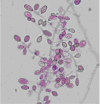Severe osteomyelitis caused by Myceliophthora thermophila after a pitchfork injury
- PMID: 16961922
- PMCID: PMC1592504
- DOI: 10.1186/1476-0711-5-21
Severe osteomyelitis caused by Myceliophthora thermophila after a pitchfork injury
Abstract
Background: Traumatic injuries occurring in agricultural settings are often associated with infections caused by unusual organisms. Such agents may be difficult to isolate, identify, and treat effectively.
Case report: A 4-year-old boy developed an extensive infection of his knee and distal femur following a barnyard pitchfork injury. Ultimately the primary infecting agent was determined to be Myceliophthora thermophila, a thermophilic melanized hyphomycete, rarely associated with human infection, found in animal excreta. Because of resistance to standard antifungal agents including amphotericin B and caspofungin, therapy was instituted with a prolonged course of terbinafine and voriconazole. Voriconazole blood levels demonstrated that the patient required a drug dosage (13.4 mg/kg) several fold greater than that recommended for adults in order to attain therapeutic blood levels.
Conclusion: Unusual pathogens should be sought following traumatic farm injuries. Pharmacokinetic studies may be of critical importance when utilizing antifungal therapy with agents for which little information exists regarding drug metabolism in children.
Figures
Similar articles
-
Scedosporium prolificans osteomyelitis in an immunocompetent child treated with a novel agent, hexadecylphospocholine (miltefosine), in combination with terbinafine and voriconazole: a case report.Clin Infect Dis. 2009 May 1;48(9):1257-61. doi: 10.1086/597772. Clin Infect Dis. 2009. PMID: 19320594
-
Acremonium vertebral osteomyelitis: molecular diagnosis and response to voriconazole.Clin Infect Dis. 2007 Jul 1;45(1):e5-6. doi: 10.1086/518700. Epub 2007 May 23. Clin Infect Dis. 2007. PMID: 17554690
-
Post-traumatic Pseudallescheria apiosperma osteomyelitis: positive outcome of a young immunocompetent male patient due to surgical intervention and voriconazole therapy.Mycoses. 2011 Oct;54 Suppl 3:43-7. doi: 10.1111/j.1439-0507.2011.02106.x. Mycoses. 2011. PMID: 21995662 No abstract available.
-
Paecilomyces lilacinus infection in a liver transplant patient: case report and review of the literature.Transpl Infect Dis. 2008 Apr;10(2):117-22. doi: 10.1111/j.1399-3062.2007.00248.x. Epub 2007 Jul 1. Transpl Infect Dis. 2008. PMID: 17605741 Review.
-
The role of voriconazole in the treatment of central nervous system blastomycosis.Ann Pharmacother. 2009 Oct;43(10):1696-700. doi: 10.1345/aph.1M010. Epub 2009 Sep 1. Ann Pharmacother. 2009. PMID: 19724015 Review.
Cited by
-
Voriconazole pharmacokinetics and pharmacodynamics in children.Clin Infect Dis. 2010 Jan 1;50(1):27-36. doi: 10.1086/648679. Clin Infect Dis. 2010. PMID: 19951112 Free PMC article.
-
[Invasive mycoses and trauma].Wien Med Wochenschr. 2007;157(19-20):482-9. doi: 10.1007/s10354-007-0463-1. Wien Med Wochenschr. 2007. PMID: 18030552 German.
-
Voriconazole pharmacokinetics and safety in immunocompromised children compared to adult patients.Antimicrob Agents Chemother. 2010 Aug;54(8):3225-32. doi: 10.1128/AAC.01731-09. Epub 2010 Jun 14. Antimicrob Agents Chemother. 2010. PMID: 20547816 Free PMC article. Clinical Trial.
-
Melanized fungi in human disease.Clin Microbiol Rev. 2010 Oct;23(4):884-928. doi: 10.1128/CMR.00019-10. Clin Microbiol Rev. 2010. PMID: 20930077 Free PMC article. Review.
-
Osteoarticular Mycoses.Clin Microbiol Rev. 2022 Dec 21;35(4):e0008619. doi: 10.1128/cmr.00086-19. Epub 2022 Nov 30. Clin Microbiol Rev. 2022. PMID: 36448782 Free PMC article. Review.
References
-
- CAN O. The genus Myceliophthora. Persoonia. 1977;9:401–408.
-
- National Committee for Clinical Laboratory Standards . Reference method for broth dilution antifungal susceptibility testing of filamentous fungi: approved standard. NCCLS document M38-A. Wayne, PA, Clinical Laboratory Standards Institute; 2002.
-
- Silveira F, Nucci M. Emergence of black moulds in fungal disease: epidemiology and therapy. Curr Opin Infect Dis. 2001;14:679–684. - PubMed
Publication types
MeSH terms
Substances
LinkOut - more resources
Full Text Sources
Medical


